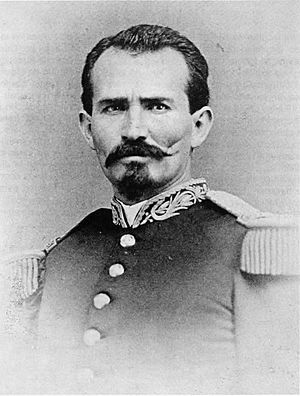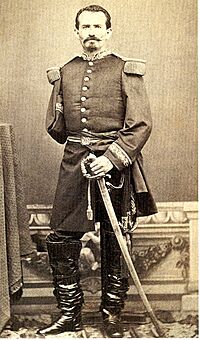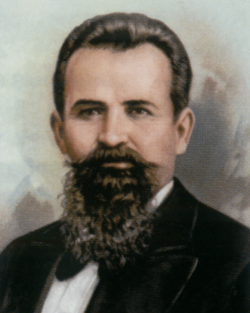Manuel González Flores facts for kids
Quick facts for kids
Manuel González Flores
|
|
|---|---|
 |
|
| 35th President of Mexico | |
| In office 1 December 1880 – 30 November 1884 |
|
| Preceded by | Porfirio Díaz |
| Succeeded by | Porfirio Díaz |
| Governor of Guanajuato | |
| In office 31 May 1885 – 8 May 1893 |
|
| Preceded by | Pablo Rocha y Portu |
| Succeeded by | Joaquín Obregón González |
| Personal details | |
| Born |
Manuel del Refugio González Flores
17 June 1833 El Moquete, Tamaulipas, Mexico |
| Died | 8 May 1893 (aged 59) Chapingo, State of Mexico |
| Resting place | Panteón de Dolores |
| Political party | Liberal |
| Spouses | Laura Mantecón Arteaga (1860-1878) |
Manuel del Refugio González Flores (born June 17, 1833 – died May 8, 1893) was a Mexican military general and a liberal politician. He served as the 35th President of Mexico from 1880 to 1884.
Before becoming president, González was a key figure in several important conflicts. He fought as a lieutenant in the Mexican–American War. Later, he was a general on the Conservative side during the Reform War. In the French intervention in Mexico, González fought for Mexico under General Porfirio Díaz. He helped Díaz become president in 1876. From 1878 to 1879, he was the Mexican Secretary of War in Díaz's government. Díaz could not be re-elected in 1880 because he had promised "no re-election." So, Díaz supported González's election, expecting him to be a loyal ally.
His time as president from 1880 to 1884 saw many important achievements for Mexico. These included successes in foreign relations and within the country. Historian Friedrich Katz called this period a "profound transformation" for Mexico.
Some people thought González's presidency was corrupt. However, this view was partly due to money problems in 1884. It was also influenced by Díaz's efforts to make González look bad. This helped Díaz get re-elected in 1884.
Contents
Early Life and Military Service
Manuel del Refugio González Flores was born in Matamoros, Tamaulipas, Mexico. Most sources say he was born on June 17, 1833. His parents were Fernando González and Eusebia Flores de la Garza. He spent part of his childhood at a ranch called El Moquete. His parents supported his education, and he was known as a bright student. After his father died, he returned home. When his mother passed away, his uncle took care of him, and he worked as a merchant.
He began his military career in 1847. He fought against invaders from the United States in the Mexican–American War. From 1853 to 1855, he fought with Conservative forces. These forces supported General Antonio López de Santa Anna. In 1854, he was with Conservative General Leonardo Márquez in Oaxaca. They were fighting against Liberal general Porfirio Díaz.
In 1856, González was hurt at the Battle of Ocotlán. He was fighting with rebels against President Ignacio Comonfort. In March 1859, he joined a Conservative attack on Veracruz. This attack was against the Liberal government of President Benito Juárez. In 1860, he accepted an offer of forgiveness for Conservatives. He then joined the Liberals to fight against Maximilian of Habsburg and the French invasion.
González served under the military command of Porfirio Díaz. He helped defend Battle of Puebla Puebla on May 5, 1862. This was a famous battle where Mexicans won a big victory against the French. He was wounded and captured but managed to escape. In 1863, Díaz made him chief of the Army of the Center. He fought with Díaz in the battles of Miahuatlán and La Carbonera in Oaxaca.
The French captured González a second time in 1865. But he was released and rejoined the Mexican army. In 1867, he took part in the sieges of Puebla and Mexico City. During the siege of Puebla, he lost his right arm. On September 7, 1867, after Juárez's forces took back the capital, Juárez made him military commander of the Federal District. He also served as governor of the National Palace from 1871 to 1873. He supported Díaz in his revolts: the Plan de la Noria (Díaz's failed revolt against Juárez in 1871) and the Plan of Tuxtepec (his successful revolt against President Sebastián Lerdo de Tejada in 1876). On March 13, 1877, he became a general of division.
Political Career
Serving Under Díaz
Díaz appointed González as governor and military commander of Michoacán from 1877 to 1879. He also served as Secretary of War and the Navy from April 28, 1878, to November 15, 1879.
In January 1880, Díaz made him Head of the Central and Western Army. His job was to end an uprising in Tepic, Nayarit. On January 12, he arrived in Tequila, Jalisco. On January 17, he reached Tepic. Two future important figures, Colonel Bernardo Reyes and Captain Victoriano Huerta, were part of his team. González worked to bring peace to the region. On May 8, he resigned from his position, as the uprisings had ended. Díaz accepted his resignation.
The 1880 Election
Porfirio Díaz could not run for president again in 1880. He chose his friend and fellow soldier, González, as the candidate. When González first arrived in Tepic, he received a grand welcome. This event was meant to help his presidential campaign. On February 5, 1880, he shared his plans for the country. On September 24, 1880, Manuel González Flores was announced as the winner of the election.
González's Presidency (1880-1884)
González Flores was president from December 1, 1880, to November 30, 1884. Porfirio Díaz was president before and after him. Díaz even served as a minister in González's government.
González had many big plans for Mexico. Many of these plans continued Díaz's goals of economic growth. Díaz's main ideas were to encourage foreign investment and improve relations with European countries. He also wanted to bring peace within Mexico. After a long time of political unrest, peace would help attract foreign money and build new things. A popular saying during this time was "order and progress," which González followed.
New laws were made to help foreign businesses invest in Mexico. A new mining law in 1884 changed who owned rights to minerals underground. It gave full rights to landowners, which helped both Mexican landowners and foreign investors. A new land law also allowed the government to sell "vacant lands." This led to more land being owned by a few people. Companies that surveyed public land received a third of the land as payment. This encouraged them to find more "public" land. González also set up farming and industrial communities with 1,500 Italians in Puebla.
González greatly increased spending on the Mexican military. He also made the rural military police stronger and more loyal to the president. The larger army helped defeat the Apache Indians in the north. This opened up new areas for people to settle and for businesses to grow. A disagreement with Guatemala over Chiapas and Soconusco was solved peacefully. Mexico gained more land in its southern region. However, the rebellious Maya Indians in Yucatan continued their fight, known as the Caste War of Yucatan, during González's presidency.
Under González, Mexico restarted relations with European countries like Britain, France, and Germany. This was important to balance the power of the U.S. in Mexico. It also helped Mexico get money from Europe. Mexico renewed ties with Great Britain after agreeing to pay back an old debt. This debt was a large amount of money (£11.5 million) and would be a burden on Mexico's treasury. When this was announced during a financial downturn, it caused protests and riots in the capital. These were put down with force, which hurt González's reputation. To help Mexico's economy grow, the Banco Nacional de México was founded, with French bankers playing a big role. Mexico also adopted the metric system of measurements on December 20, 1882. This showed a preference for ties with Europe over British/U.S. systems.
During his time as president, a railway was built from Mexico City to the border city of Paso del Norte (now Ciudad Juárez). This was very important for U.S. investment in Mexico. It also ended the old policy of keeping the U.S. away by leaving the northern desert undeveloped. Mexico also launched its first underwater cable for communication.
In 1882, he introduced nickel coins instead of silver ones. This caused prices to rise and the value of money to drop. This led to riots on December 21, 1883. González bravely faced the rioters himself and even received cheers.
During his term, the Constitution of 1857 was changed. It removed the right for the president of the Supreme Court to become president if the current one left office. Instead, the president of the Senate or the Permanent Commission would take over.
At the end of his four-year term, he stepped down. Porfirio Díaz became president again. Díaz would stay in power until 1911, when the Mexican Revolution began. Díaz often criticized González's achievements and accused him of corruption. This has made González less recognized in Mexican history. However, some historians, like Don M. Coerver, have studied his presidency in detail.
After the Presidency
After his presidency, González was accused of misusing public money in 1885. The case went to a Grand Jury, but the charges were dropped three years later, on October 30, 1888. Instead of being punished, González was elected governor of Guanajuato in 1884. He served three terms until his death from pancreatic cancer in 1893. He tried to become president again in 1887 but was not successful. He was buried in the Rotonda de las Personas Ilustres (Rotunda of Illustrious People) on May 8, 1893.
See also
 In Spanish: Manuel González Flores para niños
In Spanish: Manuel González Flores para niños



